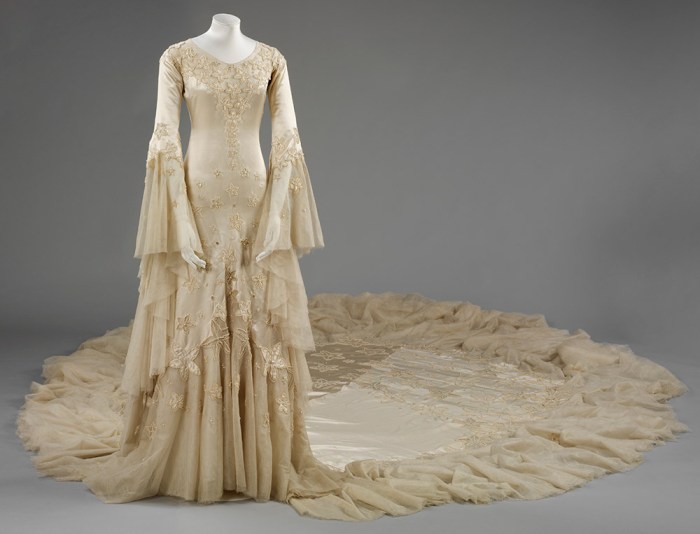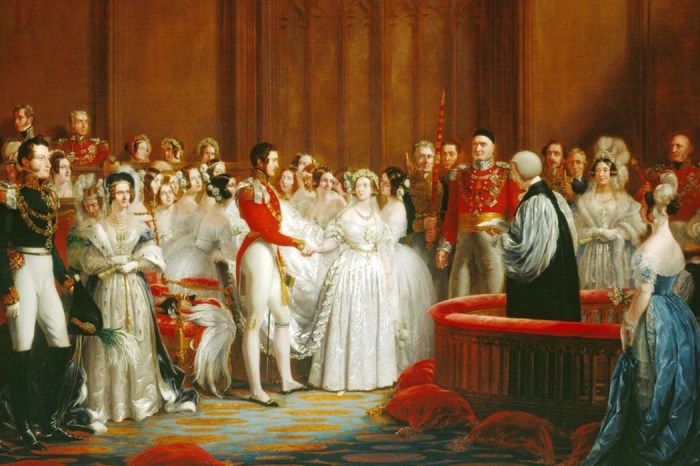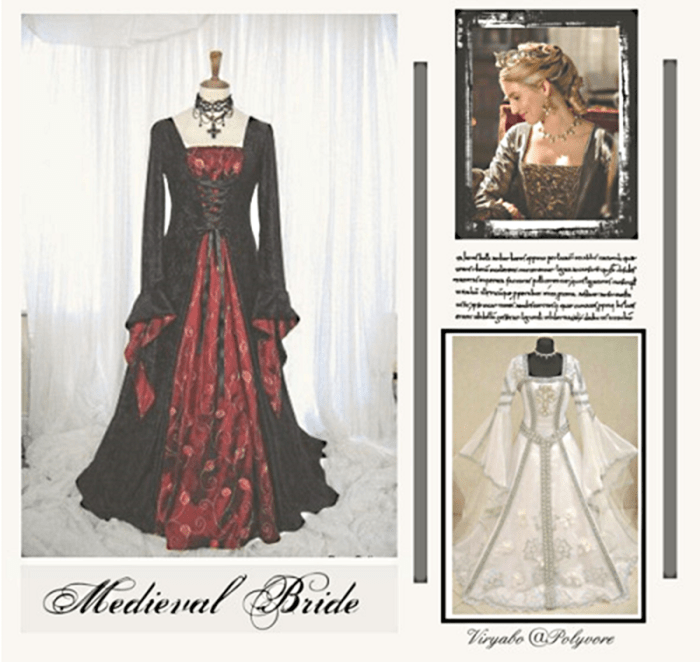Gilded Age Wedding Dresses A Timeless Elegance
Fabric and Construction of Gilded Age Wedding Dresses
Gilded age wedding dress – The Gilded Age (roughly 1870-1900) witnessed a dramatic evolution in wedding dress design, reflecting both technological advancements in textile production and the burgeoning social hierarchies of the era. The fabrics, construction techniques, and overall aesthetic of a wedding gown often served as a powerful indicator of the bride’s social standing.
Common Fabrics Used in Gilded Age Wedding Gowns
The most popular fabrics for Gilded Age wedding dresses included silk, satin, velvet, and lace. Silk, in its various forms (such as taffeta, charmeuse, and brocade), was a luxurious choice, reflecting wealth and status. Satin offered a lustrous sheen, while velvet provided a rich texture, particularly popular for winter weddings. Lace, often hand-made, added intricate detail and elegance.
Less affluent brides might opt for less expensive materials like cotton or wool, though these were less common for formal weddings.
Construction Techniques Employed in Gilded Age Wedding Dresses
The construction of Gilded Age wedding dresses was a complex process. Seams were meticulously hand-stitched, often using fine silk thread. Boning, typically made from whalebone or, later, ivory or steel, was used extensively in corsets and bodices to create structure and shape. Corsets, essential underpinnings for the fashionable silhouettes of the time, were tightly laced to cinch the waist and create an exaggerated S-bend curve.
The level of detail and craftsmanship varied greatly depending on the bride’s social class and the cost of the gown.
Comparison of Construction Methods Across Social Classes
Wealthy brides could afford elaborate gowns with multiple layers of fabric, intricate embellishments, and highly skilled craftsmanship. Their dresses often featured complex boning structures and elaborate corsetry. Middle-class brides, on the other hand, might have simpler designs with fewer layers and less intricate embellishments. Working-class brides often wore simpler dresses made from more affordable fabrics and with less elaborate construction techniques.
They might even repurpose existing garments or rely on simpler, less structured silhouettes.
Fabric and Construction Comparison Table
| Fabric | Construction Technique | Social Class | Notable Features |
|---|---|---|---|
| Silk satin, lace | Complex boning, multiple layers, hand-stitched seams, elaborate corsetry | Upper Class | Train, intricate beading or embroidery |
| Silk taffeta, simple lace trim | Less complex boning, fewer layers, machine-stitched seams | Middle Class | More modest silhouette, simpler embellishments |
| Cotton, wool | Simple construction, minimal boning or corsetry | Working Class | Plain design, minimal embellishments |
Silhouettes and Styles of Gilded Age Wedding Dresses
The silhouettes and styles of Gilded Age wedding dresses reflected the prevailing fashion trends of the era. The bustle, a padded structure at the back of the dress, was a dominant feature throughout much of the period, creating a dramatic, full shape. Other popular silhouettes included the princess line, characterized by a fitted bodice and a flowing skirt, and the more form-fitting styles that emphasized the curves of the female form.
Prevailing Silhouettes of Gilded Age Wedding Dresses
The bustle silhouette, which evolved throughout the Gilded Age, was particularly prominent. Early bustles were smaller and more naturally shaped, while later bustles became larger and more elaborate, often incorporating padding and intricate draping. The princess line offered a more streamlined and less exaggerated silhouette, providing a contrast to the dramatic fullness of the bustle. As the era progressed, some designs began to incorporate elements of both styles.
Evolution of Wedding Dress Styles Throughout the Gilded Age
Wedding dress styles evolved from the more restrained and less ornate styles of the early Gilded Age to the increasingly elaborate and opulent designs of the late 1800s. The influence of French haute couture became more pronounced as the period progressed, leading to increasingly intricate details and luxurious fabrics. The introduction of new technologies in textile production also contributed to the evolution of design, making it possible to create more complex and elaborate garments.
Comparison of Styles Across Social Classes
The styles worn by different social classes reflected their economic means and social standing. Wealthier brides could afford the most fashionable and elaborate designs, often incorporating the latest trends and the most luxurious materials. Middle-class brides typically opted for simpler versions of the prevailing styles, while working-class brides often wore more modest and practical dresses.
Visual Representation of a Typical Gilded Age Wedding Dress
Imagine a bride in a flowing silk satin gown, the bodice fitted snugly over a corset, accentuating her waist. A substantial bustle frames her rear, creating a dramatic, almost bell-shaped silhouette. Long, delicate lace sleeves fall to her elbows, framing hands adorned with delicate gloves. The skirt trails behind her in a long train, shimmering with the sheen of the satin.
Intricate beading or embroidery might adorn the bodice and sleeves, adding a touch of opulence. A high neckline and long sleeves are common, reflecting the modest standards of the time.
Embellishments and Ornamentation of Gilded Age Wedding Dresses

Source: ac.uk
The embellishments and ornamentation of Gilded Age wedding dresses played a significant role in conveying the bride’s personal style and social status. These details, ranging from delicate lace to opulent embroidery, added layers of visual richness and symbolic meaning to the gowns.
Common Embellishments Found on Gilded Age Wedding Dresses
Lace, embroidery, beading, and ribbons were common embellishments. Lace, particularly hand-made varieties, was highly valued for its intricate patterns and delicate texture. Embroidery, often in silk or metallic threads, added rich detail and could depict floral motifs, geometric patterns, or even religious symbols. Beading, ranging from delicate seed beads to larger pearls or gemstones, added sparkle and opulence.
Ribbons, often in silk or satin, were used for bows, sashes, and other decorative accents.
Symbolism Associated with Different Types of Embellishments
The symbolism of embellishments often reflected the bride’s personal beliefs or social aspirations. Floral motifs, for instance, symbolized love, fertility, and new beginnings. Religious symbols, such as crosses or doves, were common in dresses of brides from devout families. The use of pearls suggested purity and innocence, while gemstones signified wealth and status.
Examples of How Embellishments Reflected Social Status or Personal Style
Wealthier brides could afford more elaborate embellishments, such as hand-embroidered lace, intricate beadwork, and precious gemstones. These details served as visual indicators of their social standing and financial resources. Brides from less affluent backgrounds might use simpler embellishments, such as machine-made lace or ribbons, reflecting their more modest means. Personal style could also be expressed through the choice of embellishments, with some brides opting for bold and colorful designs while others preferred more subtle and understated details.
List of Embellishments and Their Associated Symbolic Meanings
- Lace: Purity, delicacy, femininity
- Flowers: Love, fertility, new beginnings
- Pearls: Purity, innocence
- Gemstones: Wealth, status
- Ribbons: Joy, celebration
- Religious symbols: Faith, devotion
Influence of Social Class on Gilded Age Wedding Dresses

Source: jstor.org
Social class played a significant role in shaping the materials, styles, and embellishments of Gilded Age wedding dresses. The gown served not only as attire for the ceremony but also as a visual representation of the bride’s social standing and family wealth.
Impact of Social Class on Materials, Styles, and Embellishments
The most striking differences between wedding dresses of various social classes lay in the fabrics used. Wealthy brides wore luxurious silks, satins, and velvets, often adorned with intricate lace and elaborate embroidery. Middle-class brides might opt for simpler silks or cotton, with less lavish embellishments. Working-class brides often wore dresses made from more affordable fabrics like cotton or wool, with minimal or no embellishments.
Comparison of Wedding Attire of Wealthy Versus Working-Class Brides
The contrast between the wedding attire of wealthy and working-class brides was stark. Wealthy brides’ dresses were often elaborate affairs, showcasing the latest fashion trends and the most expensive fabrics and embellishments. Working-class brides, on the other hand, typically wore more simple and practical dresses, often made from readily available materials and with minimal embellishments. The difference reflected not only economic disparities but also the social values and expectations of the time.
Display of Wealth in Upper-Class Wedding Dresses
For upper-class brides, the wedding dress was a statement of wealth and social status. The use of expensive fabrics, intricate embellishments, and skilled craftsmanship served to display the family’s financial resources and social standing. The extravagance of the dress was often intended to impress guests and solidify the family’s position within society.
Social Class Comparison Table
| Social Class | Typical Fabrics | Common Silhouettes | Characteristic Embellishments |
|---|---|---|---|
| Upper Class | Silk, satin, velvet, lace | Bustle, princess line | Intricate lace, embroidery, beading, gemstones |
| Middle Class | Silk taffeta, cotton | Simpler bustle, princess line | Simple lace trim, ribbon accents |
| Working Class | Cotton, wool | Simple, less structured silhouettes | Minimal or no embellishments |
The Photography of Gilded Age Wedding Dresses

Source: saymedia-content.com
Photography played a crucial role in documenting and shaping perceptions of Gilded Age wedding dresses. The early photographic techniques of the era, while limited in their capabilities, captured the essence of these elaborate garments and the social context in which they were worn.
Photographic Techniques Used to Capture Images of Gilded Age Wedding Dresses
Early photography relied on long exposure times, requiring subjects to remain still for extended periods. This often resulted in posed and somewhat formal portraits. The use of natural light was common, though photographers sometimes used artificial lighting to supplement sunlight. The development of faster photographic emulsions towards the end of the Gilded Age allowed for shorter exposure times, resulting in more dynamic and less posed images.
How Photographic Representations Shaped Public Perceptions of Ideal Wedding Attire
Photographic representations of wedding dresses helped to establish and disseminate ideas about ideal wedding attire. Images of elaborately dressed brides, often from the upper classes, set the standard for what was considered fashionable and desirable. These images influenced not only the styles of wedding dresses but also the expectations surrounding weddings as grand and opulent events.
Poses and Settings Commonly Used in Gilded Age Wedding Photographs
Wedding photographs from the Gilded Age often featured posed portraits of the bride, either alone or with her groom. The bride’s attire was prominently displayed, showcasing the details of her dress. Settings varied, ranging from formal studios to outdoor locations, such as gardens or estates. The overall aesthetic aimed to capture the elegance and formality of the wedding ceremony.
Detailed Description of a Typical Gilded Age Wedding Photograph
Imagine a sepia-toned photograph depicting a bride in a voluminous silk satin gown, her figure emphasized by a structured corset and bustle. Her expression is serene and composed, her gaze directed slightly away from the camera. She stands in a formal studio setting, against a backdrop of draped fabric or painted scenery. Her hands are gently clasped, possibly holding a bouquet of flowers.
The intricate details of her dress, such as lace, embroidery, or beading, are clearly visible. The overall effect is one of elegance, formality, and timeless beauty.
Questions Often Asked
How were Gilded Age wedding dresses preserved?
Many were carefully stored in cedar chests or trunks to protect them from moths and damage. Some families passed them down through generations.
Were there any specific colors besides white popular for Gilded Age wedding dresses?
While white became increasingly popular towards the end of the era, other colors like cream, ivory, and even pastels were also seen, particularly among those of lower social classes.
What happened to wedding dresses after the wedding?
Often, the dresses were repurposed. Fabrics were reused for other garments, or the dress itself was altered and worn for other special occasions.
Were there any specific regional variations in Gilded Age wedding dresses?
Yes, regional variations existed, reflecting local traditions and available materials. For example, rural brides might have incorporated local embroidery or fabrics.



















